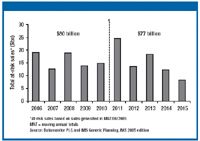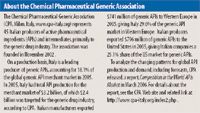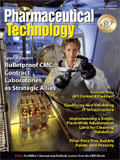The Changing Fortunes of APIs
In 2007, the global pharmaceutical market is expected to grow moderately while biologics, generic drugs, and specialty-initiated drugs are projected to increase at double-digit rates. These trends for finished pharmaceuticals are reflected in the global market for active pharmaceutical ingredients (APIs), where the merchant generic API market is expected to see strong demand. On a production basis, India and China are forecast to raise their shares of the global generic API market against industry strongholds Italy and Spain. Meanwhile, the United States is expected to hold its its position as the leading producer of biotechnology-based APIs in an area traditionally dominated by captive production. And biogenerics or biosimilars gradually reshape the market.
In 2007, the global pharmaceutical market is expected to grow moderately while biologics, generic drugs, and specialty-initiated drugs are projected to increase at double-digit rates. These trends for finished pharmaceuticals are reflected in the global market for active pharmaceutical ingredients (APIs), where the merchant generic API market is expected to see strong demand. On a production basis, India and China are forecast to raise their shares of the global generic API market against industry strongholds Italy and Spain. Meanwhile, the United States is expected to hold its its position as the leading producer of biotechnology-based APIs in an area traditionally dominated by captive production. And biogenerics or biosimilars gradually reshape the market.
Global pharmaceutical outlook
Global pharmaceutical sales are expected to increase 5–6% in 2007 to reach $665–685 billion, down from a growth of 6–7% in 2006, according to a recent analysis by IMS Health (Fairfield, CT). Despite this slowing growth, certain sectors are projected to register strong demand in 2007. Growth in biotechnology products is tagged at 13–14%, specialty-initiated products at 10–11%, and generic drugs at 13–14%.
Tracking key products in 2007
Despite slowing growth for global pharmaceutical sales in 2007, the total number of blockbuster products is growing and is expected to reach 112 in 2007, according to IMS. (IMS defines blockbusters as pharmaceutical products with annual sales of at least $1 billion).
Examples of drugs with blockbuster potential expected to be launched in 2007 include paliperidone by Johnson and Johnson (J&J, New Brunswick, NJ), desvenlafaxine by Wyeth (Madison, NJ), and rimonabant by Sanofi-Aventis (Paris), according to IMS.
Table I shows the rankings for the top-selling global pharmaceutical brands as of June 2006, outlines Diana Conmy, director of IMS Market Insights. Several of these top-selling drugs either lost US patent protection in 2006 or will in 2007. Merck & Co. Inc.'s (Whitehouse Station, NJ) "Zocor" lost US patent protection in 2006, and the patent for Sanofi-Aventis's "Plavix" was challenged. In 2007, Pfizer, Inc.'s (New York, NY) "Norvasc" and "Risperdal" by J&J subsidiary Janssen LP will lose patent protection.

Table I: Top 10 brands by global pharmaceutical sales, June 2006*.
Generic drug outlook strong
As a result of these and other high-profile patent expiries, the global generic drug market is poised for strong growth. Drugs with sales of $160 billion are expected to come off patent by 2015, according to Datamonitor PLC (London, UK). "It is expected that the raft of blockbuster patent expiries that will occur over the next ten years will lead to a rise in the volume of the generics market," explains Joanna Chertkow, pharmaceutical lead analyst at Datamonitor. She explains, however, that growth in volume sales is unlikely to translate into a significantly higher value for the generics market because of greater scrutiny of drug prices in the major national markets, including the United States.
As outlined in Figure 1, 2008 and 2011 are projected as particularly strong years for growth in generic drugs. "Within the next five years, an estimated $80 billion in 2005 product sales will be exposed to generic competition, while a further $77 billion will be subject to generic incursion between 2011 and 2015," says Datamonitor's Chertkow.

Figure 1: At risk pharmaceutical sales based on generic competition. 2008 and 2011 are expected to be the next bumper years for generic drugs.
In addition to Zocor in 2006 and Norvasc and Risperdal in 2007, IMS's Conmy points to other patent expiries. For 2006, key drugs coming off patent included Pfizer's "Zoloft" (sertraline), Bristol-Myers Squibb Company's (New York, NY) "Pravachol" (pravastatin), GlaxoSmithKline PLC's (GSK, London) "Zofran" (ondansetron) and "Flonase" (fluticasone), and Boehringer Ingelheim's (Ingelheim, Germany) "Mobic" (meloxicam). And in 2007, key drug coming off patent are Pfizer's "Zyrtec" (cetirizine), GSK's "Coreg" (carvedilol), and Sanofi-Aventis's "Ambien" (zolpidem).
Global API market
The projected uptick in volume demand for generic drugs translates to increased demand for generic APIs as a forecast of the global API market shows.
The global market for APIs for human use reached $76 billion in 2005, according to the Chemical Pharmaceutical Generic Association (CPA) (1). This figure includes APIs and advanced intermediates used in producing APIs. Of this total, roughly 59% (or $45 billion) are produced captively by pharmaceutical companies, according to CPA. The remaining 41% (or $31 billion) is produced for the merchant market, defined as APIs produced by third parties and sold to pharmaceutical companies. Active ingredients account for roughly 70–75%, or $22–23 billion, of the merchant market, and advanced intermediates for the remaining 25–30%, or $8–9 billion, according to CPA. In 2005, generic APIs accounted for 43.5% (or $13.5 billion) of the total merchant API market (including both APIs and advanced intermediates). Branded or innovative APIs accounted for 56.5% or $17.5 billion (1).
Outlook for the merchant API market. Global demand for APIs as a whole (both branded or innovative and generic APIs) is expected to increase at an average annual rate of 8.2% over the next five years, according to CPA. The merchant market for APIs is expected to reach $46 billion by 2010, with demand for generic APIs growing faster than APIs for branded or innovative drugs. Demand for generic APIs is projected to increase at an annual average rate of 10.9% over the next five years to reach $22.7 billion by 2010. In contrast, demand for APIs for branded or innovative drugs is forecast to increase at an annual average rate of 5.9% to reach $23.3 billion by 2010. This differential in growth rates will shift the balance of API power to near parity by 2010 with generic APIs at 49.4% and branded or innovative APIs at 50.6%, according to CPA (1).
Global API demand patterns. On a consumption basis, North America is by the largest market for merchant APIs, with a total value of $14.13 billion in 2005. Branded or innovative APIs account for $10.7 billion and generic APIs $3.4 billion, according to CPA. The United States accounts for the lion's share of the North American API market: $13.3 billion in 2005, with $10.1 billion for APIs for branded or innovative products, and $3.2 billion for generics. By 2010, demand for merchant APIs in the United States is expected to increase to $18.4 billion: $13.7 billion for branded drugs and $4.7 billion for generics (1).

About the Chemical Pharmaceutical Generic Association
In 2005, Western European demand for merchant APIs was $6.6 billion: $4.1 billion for branded or innovative products and $2.5 billion for generics (1).
In Asia, generic APIs dominate the merchant API market. Total merchant API demand in 2005 in Asia was nearly $7.0 billion, with generic APIs accounting for roughly $4.5 billion and branded or innovative APIs $2.5 billion (1).
The fastest growth rates for the merchant API market through 2010 are expected in the Asia-Pacific region, with an average annual increase of 13.7% for both generic and branded or innovative APIs. Demand for generic APIs will increase by a yearly average of 16.9% and 6.9% for innovative APIs, notes CPA. Unlike in other Asian countries, demand for branded or innovative APIs are expected to grow faster in China and India, although they still are a niche market in those countries (1).
A breakdown shows that in China, the market for APIs as whole (both generic and branded APIs) is expected to increase from $2.3 billion in 2005 to nearly $5.7 billion in 2010, representing average annual growth of 19.3%. The market for generic APIs is expected to increase at a yearly average rate of 19.1% to $5.1 billion in 2010. Demand for branded or innovative APIs, is expected to increase at a yearly average rate of 22% to $517 million in 2010 (1).
In India, the market for APIs as a whole (generic and branded) is expected to increase from $755 million in 2005 to $1.9 billion in 2010, representing average annual growth of 20.5%. Generic APIs will increase at an average annual rate of 19.9% to reach $1.6 billion in 2010. Branded APIs will increase at a yearly average rate of 24.5% to reach $284 million in 2010 (1).
Global production for merchant APIs. On a production basis, Italy has been a leader in producing generic APIs, followed by Spain, according to CPA. In 2005, Italy produced $3.2 billion worth of APIs for the merchant market, of which $2.4 billion was targeted for the generic drug industry. Italian producers exported $741 million of generic APIs to Western Europe and $796 million to the United States (1).
Spain's total API production in 2005 was $1.02 billion, of which $820 million was for the generic drug industry. Spanish APIs producers exported $380 million to the United States and $208.2 million to Western Europe, according to CPA (1).
India and China are the two main competitors for API production against the strongholds of Italy and Spain. China and India supplied roughly 57% of the generic APIs to Western Europe and 15–16% of the generic APIs to the United States in 2005. By 2010, India and China are expected to hold 66% of the Western European market for generic APIs and 24% of the US market (1).
The increase in the generic API market share for India and China into the US market will come at the expense of Italy and Spain. In 2005, Italy accounted for 25.1% of the US generic API merchant market; Italy's share is projected to decrease to 19.5% by 2010. Spain's share of the US merchant generic API market is also projected to decrease from 12% in 2005 to 8.4% in 2010 (1).
Meanwhile, the market share held by Indian API manufacturers in the global API merchant market (both generic and branded) is expected to increase from 6.5% in 2005 to 10.5% in 2010. Indian API sales are projected to show the fastest growth rates (average annual) on a worldwide basis, nearly 19.3%, with growth to the US generics market at 31.3% through 2010, according to CPA. In 2005, India companies sold $130 million of generic APIs to the US market and $434 million to Western Europe (1).
The market share held by Chinese API manufacturers in the global API merchant market (generic and branded) is expected to increase from 14.2% in 2005 to 21.5% in 2010. Chinese API sales (generic and branded) are expected to grow 17.6% annually on average through 2010 and by 12.2% to the US generics market. In 2005, Chinese API manufacturers sold $980 million of generic APIs to Western Europe and $365 million to the United States (1).
Demand patterns for biotech APIs. Unlike the API market for small molecules, the market for biotech-based APIs is largely captive. The demand for biotech APIs was valued at $7.4 billion in 2005, according to CPA, and is expected to increase at a yearly average rate of 15.5% to reach $15.2 billion by 2010. In 2005, 50% of the market consisted of five major product types: erythropoietin, monoclonal antibodies, colony-stimulating factors, human insulin, and recombinant human growth hormone (1).
The United States is the largest producer of biotech APIs, at $4.25 billion, or 57.4% of the total market, according to CPA. Biotech API production in North America is projected to increase 14.4% annually on average to reach $8.9 billion in 2010. The Asia-Pacific region is projected to be the second largest producer of biotech APIs, with an average annual growth rate of 27.1% to reach nearly $3.6 billion in 2010, mainly from expected production of biogenerics (1).
Outlook for biologics
The growth in biotech API production parallels the growth of biologics. During the forecast period of 2004-2010, Big Pharma' sales of biologics is expected to grow at an compound annual growth rate of 13% (2). Led by Roche (Basel, Switzerland), Figure 2 outlines the penetration of biologics in ethical drug revenues of the major pharmaceutical companies.

Figure 2: Big Pharmaôs ethical drug sales split by biologics and nonbiologics revenues.
Genentech, Inc.'s (South San Francisco) "Lucentis" (ranibizumab) and Merck & Co.'s "Gardasil" (quadrivalent human papilloma virus, types 6, 11, 16, 18 recombinant vaccine) are two biologics launched in 2006 with strong performance potential, notes analysts. GSK's "Cervarix," also a vaccine against a human papilloma virus, is expected to launch in 2007 with strong prospects.

Company Web sites
Biogenerics or biosimilars. As biologics assume a larger share of Big Pharma's ethical drug sales, the impact of biogenerics (known as biosimilars in Europe) will be key. Because of biogeneric erosion, the market for branded biologics in four key classes in the United States is expected to decline, explains Andrew G. Merseth, analyst with Decision Resources (Waltham, MA). Merseth also is author of a recent report, Biogenerics 2006–2015: An Emerging Reality for Biologics Brands. The US branded market for erythropoiesis-stimulating proteins (ESPs), granulocyte-colony stimulating factors (G-CSFs), insulins and insulin analogues, and human growth hormone (hGH) was $9.5 billion in 2006, and is expected to fall to $8 billion in 2012, and to $3.8 billion by 2015, notes Decision Resources.
"Epogen" (epoetin alfa) by Amgen (Thousand Oaks, CA) and J&J's "Procrit" and "Eprex" (epoetin alfa) are examples of two key biologic products in the ESPs class losing US patent protection in 2013. Amgen also faces US patent expiration in 2013 for the G-CSF "Neupogen" (filgrastim), according to Decision Resources.
Patents for insulin for Eli Lilly's (Indianapolis, IN) "Humulin" and Novo Nordisk's (Bagsværd, Denmark) "Novolin" already have expired, and insulin analogues face near-term patent expiration in the United States in 2013–2015. These analogues include Eli Lilly's "Humalog," Novo Nordisk's "NovoLog" and "Levemir," and Sanofi-Aventis's "Lantus," says Decision Resources.
hGH products that face near-term US patent expiration include Eli Lilly's "Humatrope" and Pfizer's "Genotropin" in 2008, Genentech's "Nutropin" in 2009, and Novo Nordisk's "Norditropin" in 2015, although patent protection does not necessarily ensure that competition will not reach the market.
The approval of Sandoz's (Holz-kirchen, Germany) "Omnitrope" (somatropin recombinant) as a follow-on protein by the US Food and Drug Administration in 2006 fueled the ongoing debate in the United States regarding regulatory pathways for approving biogenerics. Omnitrope was one of the first drugs approved under the biosimilar pathway established by the European Commission.
Although the regulatory framework for biosimilars is more defined in Europe, Merseth sees the United States moving toward standardized pathways for biogenerics, although this is a slow and evolving process, which is expected to continue over the next few years.
"We believe that that FDA's approval of Sandoz's Omnitrope demonstrated that the 505 (b)(2) pathway [under the Food, Drug, and Cosmetic Act] is available and open to biogenerics that demonstrate comparability with biologics regulated under new drug applications (NDAs) and are well characterized, simple proteins with clear mechanisms of action, and long clinical histories," says Merseth. Human growth hormone and insulin products, all of which are licensed as NDAs, fall into this category.
The key issue for the US market, therefore, relates to the vast majority of biologics, which are regulated under biologics license applications (BLAs) rather than NDAs. "We expect Congress to enact legislation allowing biogeneric abbreviated BLAs in the 2007–2008 time frame and for the first biogenerics comparable product comparable to BLA products to arrive no sooner than 2009," says Merseth, with 2010 or later being a more likely scenario given the lack of current guidelines from FDA and the regulatory complexities involved.
References
1. "Competition in the World APIs Market," Chemical Pharmaceutical Generic Association (Milan, Italy, March 2006).
2. S. King, "The Evolving Pharmaceutical Value Chain: Forecasting Growth for Small and Large Molecules," Pharm Technol. 30 (10), "Technology Outlook: APIs, Intermediates, and Formulation" supplement, s6–s10 (2006).

Drug Solutions Podcast: A Closer Look at mRNA in Oncology and Vaccines
April 30th 2024In this episode fo the Drug Solutions Podcast, etherna’s vice-president of Technology and Innovation, Stefaan De Koker, discusses the merits and challenges of using mRNA as the foundation for therapeutics in oncology as well as for vaccines.
Drug Solutions Podcast: Applying Appropriate Analytics to Drug Development
March 26th 2024In this episode of the Drug Solutions Podcast, Jan Bekker, Vice President of Business Development, Commercial and Technical Operations at BioCina, discusses the latest analytical tools and their applications in the drug development market.
INTERPHEX 2025: Use of Walk-In Chambers for Bio/Pharma Development and Manufacturing
April 2nd 2025Sitting down with the PharmTech Group at INTERPHEX 2025, Christopher Murphy, director of Global Business Development and Service Customer Support at Environmental Specialties, discusses the design and critical role of walk-in chambers in the bio/pharmaceutical industry.